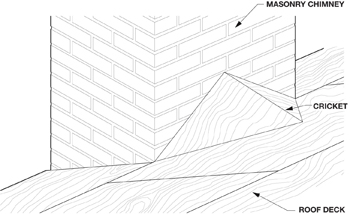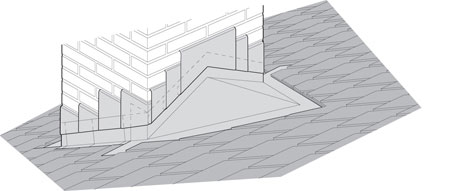When installing asphalt shingle roof systems, contractors often encounter brick masonry chimneys. If not properly detailed, water may leak where a chimney intersects a roof system's plane. One common method to avoid such a problem is to install a cricket.
A cricket is a relatively small roof area constructed to divert water from a horizontal intersection of a roof and chimney. NRCA recommends crickets be installed at the upslope side of chimneys when a large volume of water, snow, ice or debris is expected; the chimney is more than 24 inches wide; or the roof slope is 6-in-12 (27 degrees) or greater.
Crickets typically are constructed from metal. The metal type and thickness used for cricket flashings should be commensurate with the anticipated service life of the asphalt shingle roof system. NRCA suggests cricket flashings for an asphalt shingle roof system be fabricated from one of the following metal types and thicknesses:
In some regions, particularly those with mild climates, other types of metal and/or metals of lesser thicknesses than previously mentioned may be used successfully. NRCA considers these applications to be area practices. NRCA does not recommend the use of prefinished or other metals that do not allow soldering or welding.


Figures courtesy of The NRCA Roofing and Waterproofing Manual, Fifth Edition, Volume 2
Figure 1 shows an example of a wood cricket built on the upslope of a chimney, and Figure 2 shows an example of cricket flashing for the upslope of a chimney.
If a cricket is wider than 18 inches, NRCA suggests wood framing be installed at the underside to support the cricket (see Figure 1).
Before any flashing is applied, underlayment should be applied to the roof deck around a chimney. However, in moderate and severe climates, before an underlayment is applied, an ice-dam protection membrane should be installed around a chimney. If appropriately specified and constructed, an ice-dam protection membrane can help prevent water leakage.
Cricket flashing requires some form of counterflashing to cover and protect the top edges from water infiltration (see Figure 2). At brick masonry, metal counterflashing should be installed. Metal counterflashings can be embedded in a masonry joint, inset into a raggle or surface-mounted.
Joan P. Crowe, AIA, is an NRCA director of technical services.
COMMENTS
Be the first to comment. Please log in to leave a comment.